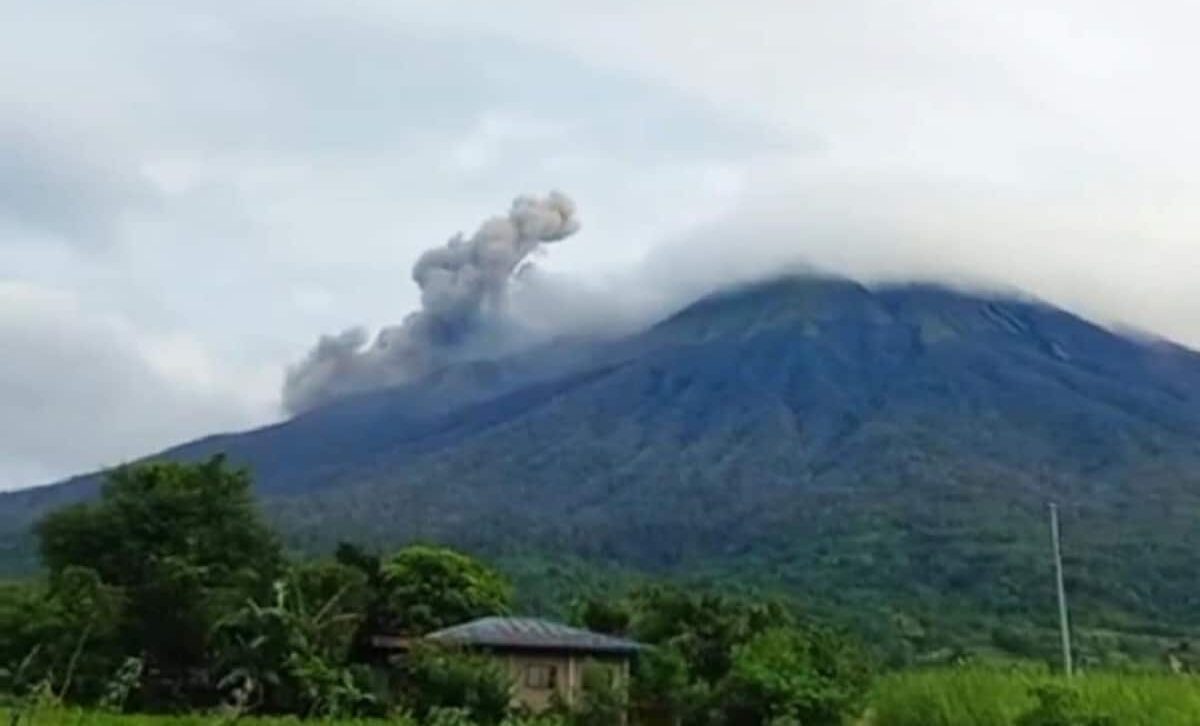
ASH EMISSION Mt. Kanlaon, which remains under alert level 3, continues to emit ash as seen from La Castellana town, Negros Occidental, on Dec. 28. —Photo courtesy of Jerick Recaplaza
BACOLOD CITY, NEGROS OCCIDENTAL, Philippines — The provincial board of Negros Oriental has placed the entire province under a state of calamity to address the needs of localities and residents affected by the Dec. 9 eruption of Mt. Kanlaon.
The calamity status would enable the provincial government to use its quick response fund to address the needs of the evacuees in the province.
The board approved the recommendation of the Provincial Disaster Risk Reduction and Management Council (PDRRMC) for the declaration of a state of calamity in a special session on Dec. 27.
READ: Negros Oriental town braces for evacuees fleeing Kanlaon
As of Dec. 26, there were 1,778 families composed of 5,802 individuals in 10 evacuation camps in Canlaon City, Negros Oriental, while 643 families with 2,014 members were living with friends and relatives.
All 7,816 evacuees had evacuated from the Mt. Kanlaon 6-kilometer danger zone on the Canlaon City side.
The Negros Oriental PDRRMC made its recommendation for the declaration of a state of calamity in the entire province after the town of Vallehermoso, which is being positioned to accept spillover evacuees from Canlaon City should the volcano erupts anew, declared a state of calamity on Dec. 20 to ensure it could immediately use its quick fund if the need arises.
The entire Negros Oriental can only declare a state of calamity if at least two of its local governments have declared the calamity status.
Canlaon City has earlier placed itself in a state of calamity since Mt. Kanlaon‘s eruption on June 3 this year.
Negros Occidental, where most of the affected areas are located with over 10,000 residents housed in shelters, declared a state of calamity on Dec. 13.
Tent cities
The province has also imposed a price freeze on basic necessities and prime commodities to ensure there will be no predatory pricing of commodities in areas affected by Mt. Kanlaon’s eruption.
Mt. Kanlaon straddles the cities of Bago, La Carlota and San Carlos, and the towns of Murcia and La Castellana in Negros Occidental and Canlaon City in Negros Oriental.
Raul Fernandez, head of the Office of Civil Defense (OCD) in Western Visayas, said tent cities will be set up to accommodate more evacuees should another eruption occur.
The tent cities in Negros Occidental will be set up in Himamaylan and Kabankalan cities and possibly Pontevedra town, which are nearer to La Castellana town where the bulk of additional evacuees are expected to come from, according to Fernandez, who also also heads the Task Force Kanlaon.
In Negros Oriental, Canlaon City’s evacuees will be accommodated in Vallerhermoso while those from Moises Padilla evacuees of Negros Occidental will be housed in Guihulngan City in Negros Oriental.
The cities of La Carlota and Bago could also care for an increase in evacuees.
Negros Occidental Gov. Eugenio Lacson said on Thursday that the danger of lahar flow from Mt. Kanlaon remains, especially if there is heavy rain.
Lahar is a destructive mudflow made up of water, volcanic ash, rock fragments, and other materials that flow down the side of a volcano to communities below.
The OCD earlier announced it may further expand the permanent danger zone surrounding Mt. Kanlaon in Negros from 6 to 10 kms if the rainy weather worsens.
An expansion would mean thousands more evacuees amid concerns raised by affected local governments about the mounting cost of caring for the current evacuees.
Agriculture damage
Already, the ashfall and evacuation have taken its toll on agriculture, with damage now reaching P33.5 million and directly affecting 780 farmers.
The Kilusang Magbubukid ng Pilipinas (KMP), in a statement on Sunday, said the government should provide immediate help to 12,000 families, or over 45,000 individuals, across 32 barangays in the Negros and Panay regions affected by the ash emission.
The eruption destroyed more than 297 hectares of farmland and 832 metric tons of produce, “severely impacting rice, corn and high-value crops,” KMP said.
However, it said, the Department of Agriculture’s “promise of zero-interest loans and limited aid is a slap in the face of farmers who have already suffered enough since El Niño hit Negros in 2023.”
The group urged the government to compensate farmers who have lost their homes, crops, livestock and farm tools, emphasizing that “relief efforts must prioritize farmers’ specific needs, including food aid, agricultural rehabilitation and access to health-care services in evacuation centers.”
Citing reports from the provincial health office, KMP pointed out that evacuees, particularly children, were getting sick because of “prolonged stays in overcrowded evacuation centers. —with a report from Gillian Villanueva